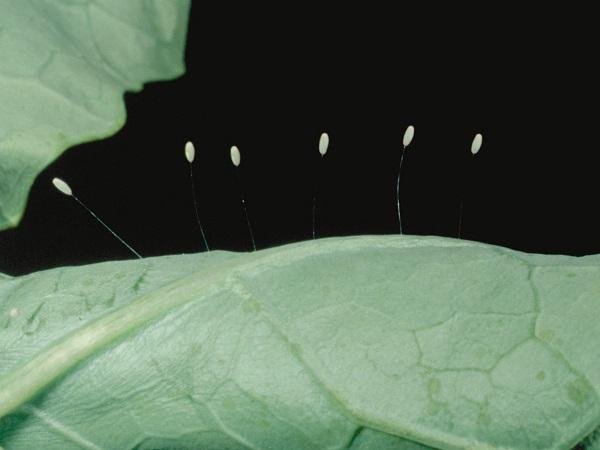Ever found weird white spots on your plant leaves and thought, “What the heck are these?” Well, buckle up, plant pals, because you might have found some white bug eggs! From friendly lacewings to pesky whiteflies and leafminers, we’re about to dive into a tiny world of garden critters. Ready?
<!> Notice: Not that any white spots you can see are white insect eggs. Especially these white eggs can be relatively small, which can be mistaken for fungal diseases, bacterial diseases, and other causes.
White Eggs Are Not The Only Reason for White Spots On Leaves
There are several reasons for white spots happening to appear on your plant leaves, including:
- Fungal Diseases: Powdery mildew is a common fungal disease, for example. This disease usually appears as a white, powdery coating on leaf surfaces and is often the result of high humidity and poor air circulation around plants.
- Insect Damage: Certain insects, like aphids, spider mites, and whiteflies, can cause white spots on leaves. These pests suck the sap from plant leaves, causing damage that can manifest as small, white, discolored spots.
- Sunscald or Light Damage: If plants are suddenly exposed to strong, direct sunlight after being in a more sheltered environment, they can experience sunscald. This damage can cause white or bleached areas on the leaves.
- Viral Diseases: Some plant viruses can cause white spots or patterns on leaves. For example, the cucumber mosaic virus (CMV) causes various symptoms, including mosaic patterns of yellow, green, and white on the leaves of infected plants.



It’s essential to accurately diagnose the cause of white spots on leaves to see if they are white insect eggs. If unsure, consider taking a sample to a local extension service or plant nursery for diagnosis. Now, we proceed with the main topic.
4 Insects That Lay White Eggs On Leaves
Numerous insects lay white or light-colored eggs on leaves. According to my experience & self-conducted research, there are four insects that might lay white eggs on your plant leaves: lacewings, spotted lanternflies, leafminers, and whiteflies. Of course, the color of these insects’ eggs depends on which stage you detect them. Details are below:
#1. Newly-laid Lacewing Eggs
Lacewings are a great ally to have in any garden. These delicate-looking insects are known for their predator prowess, especially during their larvae stage. They feed heavily on garden pests like aphids and mites, helping to keep these nuisance populations in check.
When it comes to egg-laying, lacewings have a distinct strategy. Female lacewings lay eggs on the underside of plant leaves, each delicately positioned at the end of a thin stalk. This ingenious design is a survival strategy: the stalks separate each egg to protect each of them from its cannibalistic siblings that quickly prey on each other after hatching.


Newly-laid lacewing eggs are small, oval, and usually white (or sometimes pale green). They can be found individually or in small groups, their unique stalked structure making them easy to identify. The eggs will gradually turn gray until they hatch.
When these eggs hatch, the resulting larvae, known as “aphid lions,” are keen predators, ravenously feasting on garden pests. So, if you spot these peculiar eggs under your plant leaves, it’s good news! It means these natural pest controllers are patrolling your garden. Remember, using organic or natural pest control options to protect your helpful garden buddies like lacewings is always a good idea!
#2. Mature Spotted Lanternfly Egg Mass
Spotted Lanternflies are pesky bugs from Asia that can harm our trees and crops. Spotted lanternfly eggs are masses. Interestingly, they don’t usually lay eggs on tree leaves, as we often find them on flat surfaces like tree trunks or manufactured structures. However, this insect can stick their eggs almost anywhere, so don’t be surprised if you accidentally find them on plant leaves. That’s why I still include this insect in this list.
These egg masses look like old, gray chewing gum or mud patches and are about 1-1.5 inches long. Each patch contains 30-50 eggs and is covered with a yellowish-brown substance that turns brownish-white as it ages. The bugs usually lay their eggs from September through late November or early December.
A brief treatment: Spotting their egg masses early on is essential to stop them from spreading. It’s essential to destroy the mass once you spot it. You can scrape the mass into a bag or container filled with alcohol or hand sanitizer, killing the eggs. And remember to let your local agricultural office know if you spot these eggs to help everyone keep an eye on these pests!
Reference: Spotted Lanternfly – Animal and Plant Health Inspection Service (USDA).
#3. Leafminers
Leafminers are tiny bugs that lay their eggs inside the leaves. These eggs are super small and hard to see. However, according to the image and some helpful resources I found, leafminers often lay small white eggs on newly-formed plant leaves. The baby bugs, or larvae, start eating through the leaf when they hatch. This trail looks like squiggly lines on the leaf, but this is the calling card of the leafminer.

A brief treatment: If you see these squiggly trails on your leaves, the leafminer eggs have already hatched, and the larvae are munching away. You can remove the affected leaves and throw them away to deal with them. You could also let natural predators do the work or use bug sprays as a last resort. The key is catching it early to save your plants from too much damage.
#4. Newly-laid Whitefly eggs
Newly-laid whitefly eggs are super tiny, often needing a magnifying glass to spot. The egg is pear-shaped, usually “gleaming white and darkens over time” (according to www.ncbi.nlm.nih.gov). The mama whitefly sticks them to the bottom of the leaves in a pattern that can look like a semi-circle or a spiral.
Whitefly moms lay 6-20 eggs daily on leaf undersides. The eggs start white, then turn brown before hatching in a week to ten days. Baby whiteflies look like scales and settle down to grow just hours after hatching. Depending on the temperature, they can grow up in 1-3 months or 18 days if it’s around 82°F.
This is a visually-stunning video to watch:
Reference:
- Article PMC7564875 – National Center for Biotechnology Information, from The U.S National Institution Of Health
- Whiteflies – Wisconsin Horticulture from the University of Wisconsin-Madison
A brief treatment: If you find whitefly eggs on your plants, it’s time to take action before they hatch into larvae and start munching away on your plants. You could wash them off with a strong water spray, introduce natural predators, or use a gentle insecticide soap. No matter what, the key is to stay vigilant and check your plants regularly for any signs of these tiny invaders!
Read more: What Are The White Bugs On Squash Plants?
#5. Newly-laid Pickleworm Eggs
Newly-laid pickleworm eggs are small, white, and barely visible to the naked eye. These eggs are typically deposited by adult pickleworm moths onto the undersides of leaves or in the hidden nooks and crannies of plants. Their pale coloration makes them blend in with the plant surface, making them challenging to spot without close inspection.
But here’s an interesting fact: within about 24 hours, these eggs transform color and turn yellow! It’s like a little signal that they’re maturing and getting ready to hatch. So, if you’re looking for these eggs to protect your cucurbit crops, remember to check for those yellow ones too.
How to Deal With White Spots If They Are White Insect Eggs On Leaves?
Though I have written a summary of how to deal with each insect in the above sections, here are some general tips on handling any situation you may find:
- Hand Removal: If the infestation isn’t large, you may be able to remove the eggs physically. Wear gloves and pick off the eggs or prune out the affected leaves. Dispose of these away from your plants.
- Use of Insecticidal Soap or Neem Oil: These are safe for most plants and can effectively kill many insect eggs. They should be applied directly to the eggs and regularly reapplied for the best results.
- Beneficial Insects: If you can identify the pest, you may introduce natural predators into your garden. For example, ladybugs and lacewings are predators of aphids.
- Pesticides: If the infestation is large or the above methods aren’t effective, you may need to consider a targeted pesticide. Be aware that pesticides can negatively affect beneficial insects (like lacewings I mentioned before) and the broader environment, so they should be used sparingly and as a last resort.
Final Lines
So, if you see white spots on your plant leaves, you might be looking at insect eggs, which means bugs have been visiting your plants! Don’t worry, though. You can fight back. You might pick off the eggs or use soaps to keep insects away. And if things get tricky, there are more potent bug sprays to consider, too. The best thing you can do is to keep an eye on your plants. That way, you can tackle any issues as soon as they start.
Do you enjoy this article? About insects laying colorful eggs on plant leaves, I’ve written a few posts about this topic. Insects not only lay white eggs, but they can also lay orange, red, or black eggs. See the suggestions below for your next read:
















![[GHC Featured Image] What Insects Lay White Insect Eggs On Leaves white eggs on plant leaves featured image](https://greenhousecenter.net/wp-content/uploads/2023/07/GHC-Featured-Image-What-Insects-Lay-White-Insect-Eggs-On-Leaves-696x392.jpg)





The information is really something new for me really looking forward to for more into the same.
Thank you!